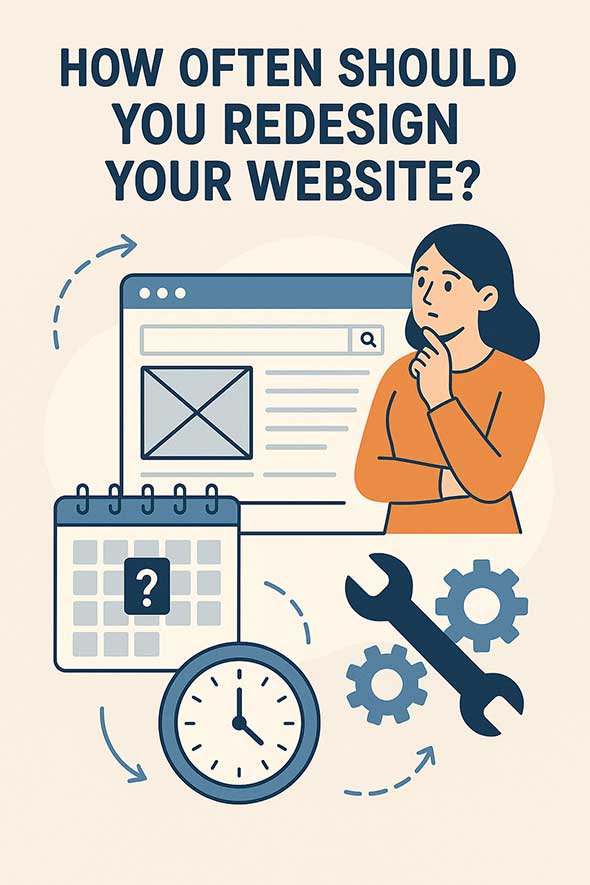For small businesses with an existing website, it’s recommended to refresh its look and design every 2-3 years. This lets you in on updates and trends in technology, new web design styles, apps and tools, and adjustments that can be made to suit present-day user expectations and behaviour. That said, there is no rule saying you want to wait either. At present, if your website is experiencing a decrease in traffic, declining performance, has clear design flaws, or if your business is about to undergo a significant shift in its branding and tonal aesthetic, these are also reasons to redesign and update your website.
When it comes a website redesign and update, here are the most common reasons why you want to prioritize it.
1. To Stay Competitive
A site that was modern two years ago may already be lagging behind in terms of aesthetics, usability, and functionality.
A routine refresh ensures that your online presence remains competitive and relevant. This could mean revising the colour palette, improving a site’s mobile responsiveness, or enhancing site speed. Even subtle updates within this window can make a meaningful difference.
2. Keep Up with The Latest Technology
New apps and software are released constantly. Some of which can offer new functionality and features that your website may benefit from.
From chatbots and CRMs to dynamic content and personalization engines, newer websites can seamlessly integrate with these tools. An older site may lack the backend flexibility to support current technology.
3. Respond to Web Design and Marketing Trends
Trends in web design and digital marketing evolve rapidly. Refreshing your website ensures you’re never caught with an outdated, unappealing presentation.
Flat design, micro-animations, and minimalism have all been recent design trends that influence user engagement. Don’t undermine your credibility by falling behind. By leaning into – or at least considering – trends, users are more likely to associate your website with professionalism and trust.

4. Improve User Experience (UX) to Retain More Users
If users struggle to find information, complete actions, or understand your layout, your UX needs a serious update. Common red flags include confusing menus, broken links, lack of mobile responsiveness, and outdated content structures.
Investing in UX improvements can increase engagement, lower bounce rates, and enhance conversion metrics. A seamless UX also contributes to brand loyalty and customer satisfaction.
5. Improve Site Speed For Users to Navigate Faster
A website that is slow, clunky, and difficult to navigate results in a poor user experience and potentially deters visitors. If your site starts loading slowly or experiencing technical issues, it may be time for a refresh. Websites built on older platforms or overloaded with outdated plugins often experience lags and crashes.
A refresh and design update keeps your site fast and its navigation intuitive, supporting a positive user experience and maximizing conversions.
6. Enhance Your On-Page SEO Strategies
A website redesign is an excellent opportunity to improve its search engine rankings with enhanced SEO.
SEO best practices are always evolving, and so are Google’s algorithms. An older site may lack schema markup, updated metadata structures, mobile optimization, or core web vitals compliance, all of which affect rankings. A redesign gives you the opportunity to rebuild your site with SEO in mind, from faster page speed to improved URL structures and content hierarchy. Enhancing your technical and on-page SEO ensures greater visibility and more organic traffic.
7. Reflect Your Brand’s Evolution and Current Presentation
As with every aspect of life, brands and businesses evolve, too. If you’ve recently updated your logo, repositioned your messaging, or added new services, your site should reflect those changes. An outdated site that no longer represents your business can confuse users and dilute your brand.
Your website should accurately represent your current identity and offerings, and be appropriately tailored to your target audience.
8. Address Security Vulnerabilities that Present Over Time
Websites using outdated CMS versions or plugins are more vulnerable to security threats. Cybersecurity risks evolve constantly, and older platforms may not receive timely patches.
A refresh helps secure your site by upgrading infrastructure, enabling HTTPS, and implementing modern security protocols. This not only protects your data but also builds trust with visitors who are increasingly wary of unsecured sites.
9. Add a New Coat Of Paint to Stale Content
Even the best-designed sites can fall behind if the content remains unchanged. Outdated blog posts, service pages, or team bios can make your site feel abandoned.
Regular refreshes give you a chance to audit and update your content to reflect current industry standards, new offerings, and changing customer interests. Content relevance also improves SEO and keeps visitors coming back.
What You Can Expect From A Website Redesign
Without a doubt, all of your favourite websites are routinely updated and refreshed to keep them user-friendly and engaging. There is no reason not to treat your website by the same standard. Here are some of the benefits of a website redesign.
- Cleaner, faster website.
- Up-to-date brand presentation.
- Improved user experience.
- Lead generation growth over the long-term.
- Higher conversion rates.
- Stronger security.
- Better search engine placements.
A well-executed redesign future-proofs your business and prepares your digital presence for what’s to come, reducing the risk of your marketing strategy being thrown completely off course or your website suddenly losing market share to a competitor.
Be sure to track KPIs (Key Performance Indicators) before and after the update. Remember: a thoughtful web design refresh is a strategic move, not just a cosmetic one. Too often, businesses wait until performance is dire before acting. Proactively refreshing your website allows for steady growth and prevents a complete overhaul down the line.
Are you ready to refresh and redesign your website? Collaborate with a local London, Ontario web design expert who can give your site the polish and functionality it needs to stay ahead of the curve and stay modern.
